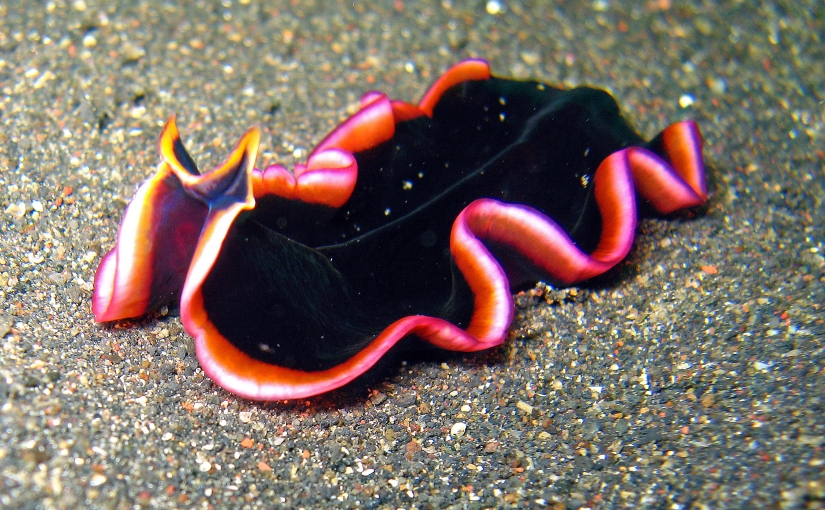Introduction
Why is it that every terrestrial creepy-crawly seems to have a marine counterpart? Slaters? How about isopods. Spiders? Try crabs. Worms? Well, let me tell you. I’ve got flatworms, I’ve got ribbon worms, I’ve even got roundworms, and you can bet your ass I’ve got ringed worms.
Phylum Platyhelminthes
Flatworms are simple folk; they are acoelomates (have no body cavity) and are restricted to a flattened body shape due to a lack of circulatory and respiratory organs. They do, however, have nervous ganglia and longitudinal nerve trunks running along their bodies. They are bilaterians and have three cell layers (endoderm, mesoderm, ectoderm) and have protonephridia which functions similarly to a kidney. Flatworms can be colourful or dull.


Class Turbellaria
Turbellarians are the more traditional class of flatworms and are represented by around 4,500 species. Most species are externally ciliated, and some have a duo-gland, an adhesive system that excretes mucous and other sticky materials to repeatedly attach and release the animal to substrates (Jennings, 1957).
The most interesting thing about Turbellarians is their reproductive strategy. All are hermaphrodites, and many of them asexually reproduce, but some species engage in a delicate, lovemaking episode known as penis fencing (Chim, Ong, & Gan, 2015; Collins III, 2017). Two flatworms will rear up, exposing two penises, and attempt to inseminate one another in a battle that can last up to an hour. They are fighting because the winner will inseminate the other and essentially become the father, free of all paternal duties and can swim away and continue with his life; the one who is inseminated must now work harder to gain the extra energy required to produce offspring.

Phylum Nemertea
These are the ribbon worms, and they move slowly with either their external cilia to glide on a trail of slime, muscular crawling, or undulated swimming. Similarly to flatworms, they are acoelomates and have a similar reproductive system, yet they differ in that they have a complete gut, circulatory system, and a proboscis.
The proboscis is an infolding of the body wall, and hydrostatic pressure “fires” the proboscis inside out to attack prey (McDermott, 1985). One type of proboscis exits from a pore that is separate from the mouth and entangles and immobilises prey with sticky, venomous secretions. A different kind of proboscis exits from the mouth and typically has a calcareous barb called a stylet to stab prey and inject it with venom and digestive fluids. Prey can then be swallowed whole, or its tissues may be sucked into the mouth.


Phylum Nematoda
Nematodes, aka the roundworms, are estimated at around 25,00 species (Hodda, 2011), although others estimate this number to be over the 1 million mark (Lambshead, 1993). They are regarded as pseudocoelomates as they have a fluid-filled cavity between the digestive tract and the body wall, although it is not lined with tissue, and there is no membrane-like tissue supporting the organs and, therefore, is not a true coelom. They have a complete digestive system and an external, collagenous cuticle, which is shed usually four times before reaching adulthood; just before the moult, the old cuticle is softened by enzymes that accumulate between the old and new cuticle until the old one is shed.

Phylum Annelida
I like to refer to annelids as your classics. They’re what you imagine when you hear the word “worm”, but they also include over 22,000 species of ragworms, earthworms, and even leeches. Between the lot of them, they have occupied a variety of niches, including tidal zones, hydrothermal vents, freshwater, and your backyard! Marine annelids have a range of habitats, life histories, and feeding strategies, making them a critical component of the oceanic ecosystem (Capa & Hutchings, 2021).
Annelids are pretty advanced. They have a complete gut, a closed circulatory system with blood vessels, bilateral symmetry, cephalisation (somewhat), and usually a pair of coelomata in each segment. Annelid segmentation facilitates the specialisation of body parts into different functions. A collagenous cuticle covers their bodies but, unlike nematodes, does not moult and has setae to provide traction.



References
Capa, M., & Hutchings, P. (2021). Annelid diversity: Historical overview and future perspectives. Diversity, 13(3), 129.
Chim, C. K., Ong, R. S., & Gan, B. Q. (2015). Penis fencing, spawning, parental care and embryonic development in the cotylean flatworm Pseudoceros indicus (Platyhelminthes: Polycladida: Pseudocerotidae) from Singapore. Raffles Bulletin of Zoology, 31, 60–67.
Collins III, J. J. (2017). Platyhelminthes. Current Biology, 27(7), R252–R256.
Hodda, M. (2011). “Phylum Nematoda Cobb 1932. In: Zhang, Z.-Q.(Ed.) Animal biodiversity: An outline of higher-level classification and survey of taxonomic richness. Zootaxa, 3148(1), 63–95.
Jennings, J. B. (1957). Studies on feeding, digestion, and food storage in free-living flatworms (Platyhelminthes: Turbellaria). The Biological Bulletin, 112(1), 63–80.
Lambshead, P. J. D. (1993). Recent developments in marine benthic biodiversity reserch. Oceanis, 19, 5–24.
McDermott, J. J., & Roe, P. (1985). Food, feeding behavior and feeding ecology of nemerteans. American Zoologist, 25(1), 113–125.
